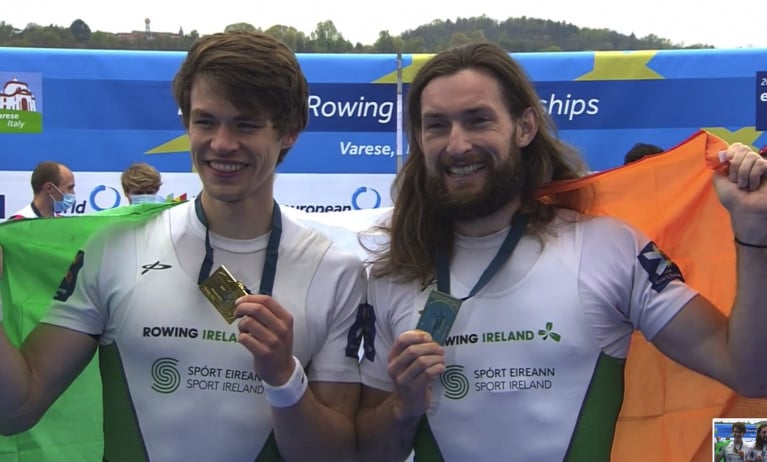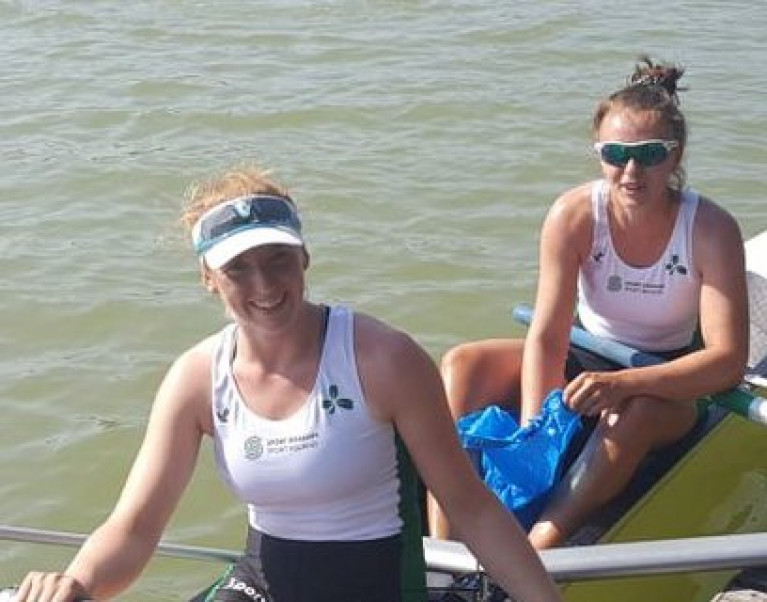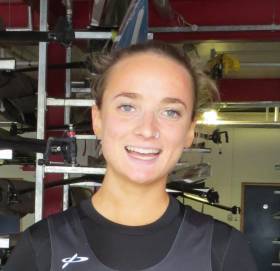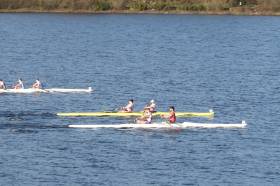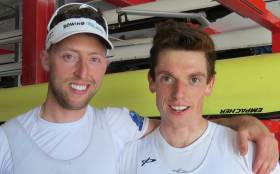Displaying items by tag: O'Donovan
Gold for O'Donovan and McCarthy at European Rowing Championships
Paul O’Donovan and Fintan McCarthy won gold for Ireland at the European Rowing Championships today in Italy, adding to an excellent silver for the women’s four earlier.
The Ireland lightweight double saw off a spirited display by Germany, who led early on. Ireland moved decisively through the middle stages and took over the lead at 1300 metres. They then sprinted through the final few hundred metres to win by a length from Germany, with Italy third.
“It was a decent race, it’s good to be back,” O’Donovan said. “I was off last season so Fintan raced in the single last year. Fintan is just dragging me along in the double. We need bigger biceps. We’re gonna work on some curls which will see us through to the end of the summer.”
The Ireland women’s four looked impressive as they took silver in Varese.
The crew of Aifric Keogh, Eimear Lambe, Fiona Murtagh and Emily Hegarty raced so well that they pushed up very close to the Netherlands in a push for gold.
The new Irish combination started slowly, but slotted into the leading trio of the Dutch, British and Irish. In the third quarter the Ireland four pushed through Britain and then tested the Dutch coming to the line.
Britain, with Rebecca Shorten of Northern Ireland in the stroke seat, took bronze.
Keogh said: “The medal this year means a lot to us because were so close to Olympic qualification. A lot of crews from Ireland are already qualified, and for us to be able to finish that close to the Dutch is a really huge confidence boost.”
Earlier, the women’s pair of Aileen Crowley and Monika Dukarska showed well in the early stages of their A Final, but in a hot race they were pushed back to sixth at the finish. Britain’s Helen Glover and Polly Swann justified their favouritism to race to gold – but they were given a battle by Romania, while Spain took the bronze.
The racy lightweight double scull of Aoife Casey and Margaret Cremen gave a good performance in a superb final. Italy were the surprise winners from Britain and the Netherlands, with Ireland taking fifth.
Gary O’Donovan had to settle for fourth in his A Final of the lightweight single sculls. The race belonged to Peter Galambos of Hungary: he led through all four quarters. O’Donovan made ground in the closing stages, but was 4.3 seconds off Galambos at the finish.
Lydia Heaphy got off to a great start in the lightweight women’s single and led early on. However, Alena Furman of Belarus moved swiftly into the lead and stretched it down much of the course to win gold. Heaphy finished sixth.
Enniskillen woman Holly Nixon teamed up in the Britain double with Saskia Budgett to take a bronze medal in a race won by Romania.
European Rowing Championships, Varese, Italy, Day Three (Irish interest)
Men
Double Sculls – B Final (Places 7 to 12): 1 Ireland (R Byrne, P Doyle) 6:21.47, 2 Italy 6:22.52, 3 Germany 6:23.29.
Single Sculls – C Final (Places 13 to 18): 1 Russia 7:08.08, 2 Ireland (D Lynch) 7:09.01.
Lightweight Double – A Final: 1 Ireland (F McCarthy, P O’Donovan) 6:18.14, 2 Germany 6:19.94, 3 Italy 6:21.05.
Lightweight Single Sculls – A Final: 1 Hungary (P Galambos) 7:01.52; 4 Ireland (G O’Donovan) 7:05.82.
Women
Four – A Final: 1 Netherlands 6:27.51, 2 Ireland (A Keogh, E Lambe, F Murtagh, E Hegarty) 6:27.96, 3 Britain (4 R Shorten) 6:31.27.
Pair – A Final: 1 Britain 7:02.73; 6 Ireland (A Crowley, M Dukarska) 7:11.83.
Double Sculls – A Final: 3 Britain (1 H Nixon) 6:55.13.
Lightweight Double – A Final: 1 Italy 6:58.66, 2 Britain 6:59.56, 3 The Netherlands 7:01.13; 5 Ireland (A Casey, M Cremen) 7:07.42.
Lightweight Single Sculls – A Final: 1 Belarus (A Furman) 7:41.81; 6 Ireland (L Heaphy) 7:58.70.
Two superb performances by lightweight doubles got Ireland off to an excellent start on day two of the European Rowing Championships in Varese today.
The men’s crew of Paul O’Donovan and Fintan McCarthy would go on to have a great win in their semi-final, but Aoife Casey and Margaret Cremen deserve the plaudits for taking second in their semi-final.
This crew is aimed at the Olympic Qualification regatta next month in Lucerne and looked to be an outside bet initially. Their performances at this regatta changed that.
In today’s semi, they showed great maturity. Italy took over early and were never headed, while Russia and Ireland tracked them in second and third. But the final quarter Ireland pushed through into a firm second place.
Cremen and Casey take their place in the A Final on Sunday. The other semi-final, won by Britain from the Netherlands, looked stronger, but Ireland even have an outside chance of a medal.
McCarthy and O’Donovan were favourites for gold right from the start. Doubts, if there were some, related to the ability of the 2019 World Champions to turn it on again after effectively missing the 2020 season, such as it was.
They had a real test in Italy, who led early and might have expected another battle in the closing stages. It never happened. Coming up to halfway, McCarthy and O’Donovan zoomed past the men in blue. They opened up the lead to clearwater and won.
Germany, who won the other semi-final, will contend on Sunday. However, their winning time was slower than the Irish today.
The Ireland double of Philip Doyle and Ronan Byrne were well off the pace in their semi-final and finished sixth. France, Britain and Switzerland got off to good starts and duly took the A Final places. Ireland had a poor start. They tried to move into contention in the middle stages but could not get a hold on the contest.
Daire Lynch qualified for the C Final (places 13 to 18) of the men’s single sculls, taking second in his semi-final.
European Rowing Championships, Varese, Italy – Day Two (Irish interest)
Men
Double Sculls – A/B Semi-Final (First Three to A Final; rest to B Final): 1 France 6:10.26, 2 Britain 6:11.17, 3 Switzerland 6:12.79; 6 Ireland (P Doyle, R Byrne) 6:21.38.
Lightweight Double Sculls – A/B Semi-Final (First Three to A Final; rest to B Final): 1 Ireland (F McCarthy, P O’Donovan) 6:22.74, 2 Italy 6:25.53, 3 Czech Republic 6:27.14.
Single Sculls – C/D Semi-Final Two (First Three to C Final; rest to D Final): 2 Ireland (D Lynch) 7:02.22.
Women
Lightweight Double Sculls – A/B Semi-Final (First Three to A Final; rest to B Final): 1 Italy 7:11.44, 2 Ireland (A Casey, M Cremen) 7:14.44, 3 Russia 7:15.46.
Women's Four and Lightweight Double Provide Highlights on Good First Day for Irish UPDATE
Ireland’s good first day at the European Rowing Championships in Varese, Italy, was all the better because two crews targeting qualification next month for Tokyo did the business.
Of the eight Ireland crews competing, the rejigged women’s four were the dark horses. Well, no more. Only by winning their heat would they qualify for the A Final. This was pressure for what is a new formation, but Aifric Keogh, Eimear Lambe, Fiona Murtagh and Emily Hegarty showed none of it. Russia led early, but Ireland took over with good speed in the middle stages and won well – in the faster time of the two heats. The Netherlands, who won the first heat from Britain, are likely to be hunting medals alongside the Irish and British on Sunday.
The lightweight women’s double is another boat targeted at the Olympic Qualifier in Lucerne, and Margaret Cremen and Aoife Casey did themselves no harm at all in their heat. They had a fuss-free qualification for their semi-final, slotting in behind the outstanding winners, Marieke Keijser and Ilse Paulis of the Netherlands. Saturday’s semi-final will be a big test of whether this crew can look to go to Tokyo: an A Final place would be hugely promising.
The draw pushed Paul O’Donovan and Fintan McCarthy into an easy heat of the lightweight double sculls, and the world champions ate up the challenge and won easily to qualify for the semi-finals.
The heavyweight double will be disappointed to have to negotiate a repechage, but they made it through by taking second behind Serbia. Ronan Byrne and Philip Doyle were the world silver medallists in 2019; in this morning's heat only a win would take them straight through to the semi-finals and their sprint finish left them short by .72 of a second, with Russia the surprise winners.
The next man up in this heavyweight group is Daire Lynch. He had a fifth-place finish in a tough heat of the men’s single sculls, which was won by Kjetil Borch of Norway. In the repechage, Lynch finished fourth and missed out on a place in the A/B semi-finals.
The women’s openweight pair of Aileen Crowley and Monika Dukarska took second in their heat to go straight to the A Final, while lightweight single scullers Lydia Heaphy and Gary O’Donovan both did well.
Heaphy looked like she might have made it hard for herself by leading to halfway, with France and Poland challenging her in the third quarter. However, Heaphy is a sterling competitor and she held off her opponents to win and go straight to the A Final.
Gary O’Donovan took the second qualification spot in his heat.
European Championships 2021, Varese, Italy
Men
Double Sculls – Heat Three (Winner to A/B Semi-Final; rest to Repechages): 1 Russia 6:17.24, 2 Ireland (R Byrne, P Doyle) 6:17.96. Repechage Three (First Two to A/B Semis; rest to C/D Semis): 1 Serbia 6:33.47, 2 Ireland 6:36.22.
Lightweight Double Sculls – Heat Three (Three to A/B Semi-Finals; rest to Repechage) 1 Ireland (F McCarthy, P O’Donovan) 6:54.75.
Single Sculls – Heat Two (Winner to A/B Semi-Final; rest to Repechage): 1 Norway 7:43.60; 5 Ireland (D Lynch) 8:14.87. Repechage Three (Two to A/B Semi-Final; rest to C/D Semi-Final): 4 Ireland 7:19.74.
Lightweight Single Sculls – Heat Two (First Two to A Final; rest to Repechage): 1 Germany 7:06.17, 2 Ireland (G O’Donovan) 7:07.23.
Women
Four – Heat Two (First to A Final; rest to Repechage): Ireland (A Keogh, E Lambe, F Murtagh, E Hegarty) 6:36.98.
Pair – Heat Two (First two to A Final; rest to Repechage): 1 Romania 7:16.40, 2 Ireland (A Crowley, M Dukarska) 7:22.04.
Lightweight Double Sculls – Heat One (Three to A/B Semi-Finals; rest to Repechage): 1 Netherlands 7:52.01, 2 Ireland (A Casey, M Cremen) 7:56.41, 3 Germany.
Lightweight Single – Heat Two (First Two to A Final; rest to Repechage): 1 Ireland (L Heaphy) 7:50.15, 2 France 7:50.40.
Ireland Crews Weather Storm and Stay on Course
#Rowing: Paul O'Donovan and Fintan McCarthy hit the right mark in their first competitive race as the new Ireland lightweight double. At the World Cup Regatta in Rotterdam, they finished .39 seconds ahead of Australia in their time trial and qualified directly for the semi-finals.
The heats were run on a time trial basis as the regatta was buffeted by a storm and racing had to be delayed and the programme altered.
All six Ireland crews made it straight through in the changed system. The Ireland men's double of Philip Doyle and Ronan Byrne posted the best time in their heat, just ahead of Switzerland, who also qualified.
Aileen Crowley and Monika Dukarska also made it straight through. The Ireland pair finished second in their time trial to the outstanding New Zealand crew of Kerri Gowler and Grace Prendergast.
Jake McCarthy and Gary O'Donovan both qualified from their heats of the lightweight single sculls. McCarthy took second and O'Donovan third.
The one Irish crew which fell outside automatic qualification was the lightweight women's double of Lydia Heaphy and Denise Walsh. They finished fourth, but made it through as one of the fastest losers.
Cremen and Fintan McCarthy Win at Skibbereen Regatta
#Rowing: Skibbereen had a one-two-three in the men's single sculls at their own regatta at the National Rowing Centre today. Gary O'Donovan, who was returning to racing after a hand injury, won his heat, but finished second to Fintan McCarthy in the final, with Aodhan Burns third. Paul O'Donovan was absent because of exam pressures.
UCC's Margaret Cremen won the women's single, while Holly Davis of Lee Valley, a junior 14 competitor, finished an excellent third. Sanita Puspure, whose boat had not made it back from the training camp in Italy, missed the event.
A tricky wind made conditions difficult, although this improved as the day went on.
The pairs titles were claimed by proven internationals: Mark O'Donovan and Shane O'Driscoll and Aifric Keogh and Monika Dukarska.
Brian Colsh of Sligo and Shauna Murtagh of Carrick-on-Shannon came out on top in the junior 18 single sculls at Portadown. The junior 16 eights titles, boys' and girls', went to Enniskillen RGS.
Doyle and Byrne Form Winning Combination at Ireland Rowing Trial
#Rowing: The double of Philip Doyle and Ronan Byrne performed brilliantly for Ireland last year, culminating with a ninth-place finish at he World Championships. They took up where they left off at the the Ireland Trial at the National Rowing Centre today. The heavyweight crew beat the lightweight double of Paul O’Donovan and Fintan McCarthy in a fine race in the first session. McCarthy and O’Donovan had never raced together before, but still finished well and were just over four seconds behind Doyle and Byrne in dead calm conditions.
Some of the contests in this first of two sessions were handicapped to produce good racing and it worked. Sanita Puspure did not win her race but had a very good time, while the pair of Aifric Keogh and Monika Dukarska won in another impressive time.
The new junior coxed four of John Kearney, Jack Dorney, James O’Donovan and Matthew Gallagher, with cox Leah O’Regan were just pipped in their race – but again excelled in terms of time for this boat.
One of the more interesting crews to be trialled was the senior four of Eimear Lambe, Aileen Crowley, Emily Hegarty and Claire Feerick. Another four was to be trialled in the second session. This opens up a possibility of a single, a pair and a four going forward on the women’s heavyweight side.
The combination of Rory O’Neill of Castleconnell and Finn O’Reilly of Skibbereen were the top men’s junior double.
O'Driscoll and O'Donovan Win at Ireland Rowing Trial
#Rowing: The top international seniors and a number of ambitious junior crews figured high in the rankings at the Ireland Trial at the National Rowing Centre today.
The battle of the men’s heavyweight pairs saw Mark O’Donovan and Shane O’Driscoll come out on top over Patrick Boomer and Fionnan Crowley. The women’s pair of Aifric Keogh and Monika Dukarska were very impressive in their win, while Paul O’Donovan – after a fine race with Ronan Byrne – won the men’s single sculls and Sanita Puspure the women’s.
Two junior crews with their eyes on the World Junior Championships excelled in their wins. The coxed four of John Kearney, Jack Dorney, James O’Donovan and Matthew Gallagher, with cox Leah O’Regan, beat an under-23 crew coxed four, while Molly Curry (Coleraine GS) and Rhiannon O’Donoghue (Killorglin) also beat the under-23 coxed four in their race.
Boomer and Crowley Pip O'Driscoll and O'Donovan at Ireland Trial
#Rowing: The new crew of Patrick Boomer and Fionnan Crowley beat Shane O’Driscoll and Mark O’Donovan in their second race of the day at the Ireland trial at the National Rowing Centre. Boomer, from Belfast Boat Club, and Castleconnell’s Crowley had just half a second to spare over the Skibbereen men.
The second session was run in bright sunshine and on good water. Chris Kirwan of St Michael’s and Grace Healy of Commercial were the top junior double – though racing from unfancied lane six. The men’s junior double was won by Andrew Sheehan of Lee and Aaron Keogh of Three Castles.
Denise Walsh and Aoife Casey, who may be the Ireland lightweight double for the season, looked impressive, while the under-23 four of Eimear Lambe, Claire Feerick, Emily Hegarty and Tara Hanlon also had a good win.
Sunday’s racing has been cancelled, because of a forecast of bad weather.
Ireland Trial, National Rowing Centre
Men
Pair: M O’Donovan, S O’Driscoll. Under-23: S O’Connell, A Goff
Jun Pair: S Daly/M Campion
Single Sculls
Lightweight: P O’Donovan. U-23 Lwt: M Taylor. Under-23: N Hull. Jun: J Kearney
Women
Pair: A Keogh, M Dukarska. Under-23: C O’Brien, K Shirlow. Jun: C O’Sullivan, J Duggan.
Single: S Puspure. Lightweight: D Walsh. U-23 Lwt: K Dolan. Jun: M Curry.
Second Session
Men
Pair: Boomer, Crowley
Four, Under-23: Goff, O’Connell, O’Rourke, Nolan
Four – Jun: Hume, Reidy, Allen, Siltanen.
Double – Lwt/U23: Sutton, Taylor. Jun: A Sheehan, A Keogh
Single – P O’Donovan. Jun: A Christie.
Women
Four – Lambe, Feerick, Hegarty, Hanlon. Jun: O’Donoghue, Tyther, McInerney, Murphy
Double – Walsh, Casey. Jun: C Kirwan, G Healy
Single: Puspure. (Jun/U23 lwt): K Dolan (u23), E Loftus.
O'Donovan and O'Driscoll Win at Ireland Trial
#Rowing: Paul O’Donovan finished fifth overall in the single sculls at the Armada Cup, and Sanita Puspure third in the Gold Cup in Philadelphia, a race that was part of the Head of the Schuylkill event.
At the Ireland trial at the National Rowing Centre, Shane O’Driscoll and Mark O’Donovan won the men’s pair on Sunday, with David O’Malley and Shane Mulvaney second. O'Driscoll and O'Donovan did not compete on the Saturday.
Jack Dorney of Shandon won both the junior single sculls and the junior double, with Castleconnell’s Rory O’Neill. Molly Curry had equivalent wins: she teamed up with Lauren O’Brien – also of Castleconnell – on the Sunday.
UCD’s men’s senior eight were fastest at the Castleconnell Head of the River, and Enniskillen junior crews also shone.
Ireland Trial, National Rowing Centre (Provisional Results; winners) Saturday
Men
Pair - Senior: UCD (S Mulvaney, D O’Malley). Under-23: UCD (S O’Connell, A Goff).
Single - Senior: Shandon (A Harrington). Under-23: UCC (R Byrne)
Women
Pair: UCC, Skibbereen (A Keogh, E Hegarty). Under-23: Neptune, UCD (C Feerick, E Lambe). Jun: Cork Boat Club (C O’Sullivan, J Duggan).
Single – Sen: Killorglin (M Dukarska). Lightweight: Skibbereen (D Walsh). Under-23 Lightweight: Skibbereen (L Heaphy). Junior: Coleraine GS (M Curry).
Sunday
Men
Four – Under-23: O’Connell, Goff, Keating, Whittle. Jun 18: Gallagher, Daly, Butler, Murphy
Pair: M O’Donovan, S O’Driscoll
Double – Sen: Haugh, Crowley. Lightweight: J McCarthy, F McCarthy. Lwt U-23: Sutton, Gaffney Jun 18: Dorney, O’Neill.
Single – Sen: Byrne. U-23: Bann (Christie). Lightweight: Sutton.
Women
Four – Under-23: Hanlon, Casey, Lambe, Feerick. Jun 18: O’Sullivan, Duggan, Tyther, O’Donoghue.
Pair – Hegarty, Keogh. Jun 18: McGrath, Gannon
Double – Sen: Dukarska, Crowley. Lightweight: Walsh, Casey. Jun 18: Curry, L O’Brien.
Single – Lightweight: Legresley. U-23: Heaphy. Jun 18: Gilmore.
#Rowing: Mark O’Donovan and Shane O’Driscoll finished fourth in the semi-final of the men’s pair at the World Cup in Lucerne today. The Skibbereen men missed out on an A Final place, but not by much. Serbia won the race well, and three other boats – Spain, Britain One and Ireland – disputed the next two qualifying spots. They finished in that order, with Ireland just over three seconds behind Britain One.
Monika Dukarska and Aileen Crowley finished fourth in the semi-final of the women’s double and are also set for a B Final. The pair of Tara Hanlon and Aifric Keogh needed to take a top-two place in their repechage to make the A Final. They took fourth and will compete in the B Final.
World Cup Regatta, Lucerne, Day Two (Irish interest; selected results)
Men
Pair – A/B Semi-Final One (First Three to A Final; rest to B Final): 1 Serbia 6:33.87, 2 Spain 6:36.65, 3 Britain One 6:38.90; 4 Ireland (M O’Donovan, S O’Driscoll) 6:42.02.
D Final (Places 19 to 24): 1 Poland 6:40.95; 5 Ireland (P Boomer, A Harrington) 6:53.83.
Single Sculls – C Final (Places 13 to 18): 1 Australia 6:58.52, 2 Argentina 6:59.65, 3 Ireland (P Doyle) 7:00.39.
Women
Pair - Repechage (First Two to A Final; rest to B Final): 1 Australia 7:18.62, 2 China One 7:19.86; 4 Ireland (A Keogh, T Hanlon) 7:29.63.
Double – Semi-Final (First Three to A Final; rest to B Final): 1 New Zealand 6:53.91, 2 Canada 6:57.71, 3 Netherlands 6:58.57; 4 Ireland (A Crowley, M Dukarska) 7:06.42.



























